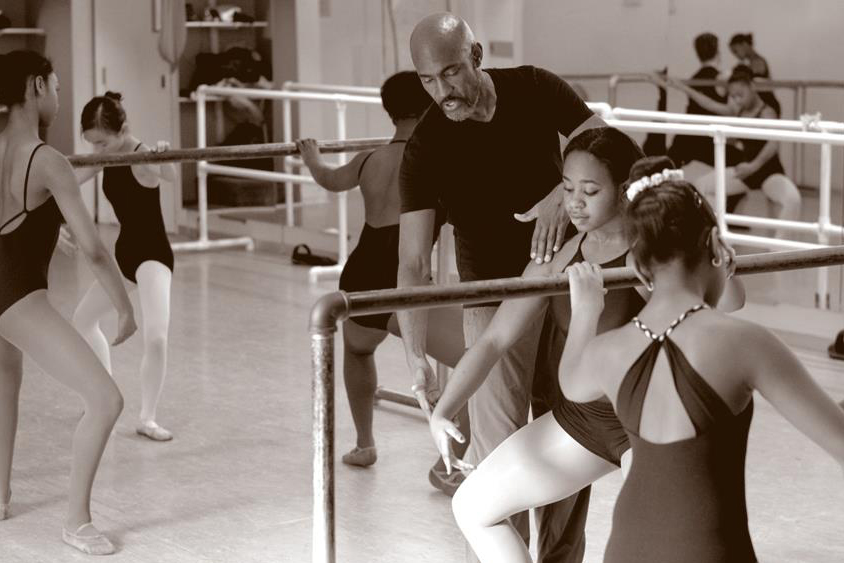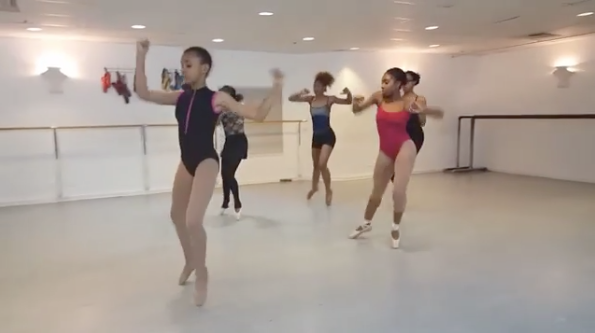The now-viral Hiplet video of black girls in pointe shoes strutting, shimmying, and dropping it low as they move across the floor to Jason Derulo’s “If It Ain’t Love” has been viewed over 8.5 million times. What makes the hip-hop-ballet combo so eye-catching? To the average audience, hip-hop moves and music don't usually go with pointe shoes and leotards. And people love seeing black girls "slay" at a traditionally white art form.
But for all the positive attention the dancers have gotten—most have applauded their style and confidence, and they've performed on multiple major TV networks since the video went viral—some viewers have attacked the Hiplet style and the legitimacy of the teacher who created it: Homer Bryant of the Chicago Multicultural Dance Center.
“The mainstream ballet world will laugh at them if they pulled this mess in an audition for a REAL ballet academy or company,” one Facebook user wrote. Others sneered at the unconventional style or worried whether it was physically safe—too often, the negative reactions were racially tinged. That was not altogether surprising to Bryant, who is a dance legend in his own right and has faced racism in the industry for years. He's spent much of his career making ballet more inclusive to people of color.
Bryant is a former principal dancer for Dance Theatre of Harlem, hand-chosen by founder Arthur Mitchell (the first black dancer in New York City Ballet). He also performed on Broadway, in the film production of The Wiz, and with the famed ballerina Maria Tallchief’s Chicago City Ballet. In 1990, he founded his school in downtown Chicago to offer all dancers—but especially low-income students and students of color—an entrée to classical ballet, a historically white and elite art form. His school is a real ballet academy, with a pre-professional training program and alumni who perform with Alvin Ailey American Dance Theater, Cirque du Soleil, on Broadway, and more.
Chicago magazine spoke with Bryant about racism in classical ballet, the Hiplet safety debate, and the role his school plays in the city.
So let’s start with your recent fame. The viral video gods have smiled on you, but Hiplet is not actually a new style for you and your students, is it?
This journey started back in the 90s. I used to do rap ballet: We got the rap ballet for you and me / with discipline, coordination, flexibility, and motivation / Ballet puts your body in touch with your mind / and the rap beat keeps you stepping on time. I would make up words about dance, discipline, positivity, and staying in school, and I’d bring the kids up to the stage and let them sing the rap with me. They were doing the running man and all the dances that were around in the ‘90s—we were doing them on pointe. When hip-hop came around I just changed the rap format to hip-hop. I started teaching Hiplet classes in 2005 and had it trademarked in 2009. This is how my school has stayed vibrant for 26 years. I stay relevant to what the kids are doing on the street, and my kids are strong enough to do it on pointe.
Why are people only looking at Hiplet, when you mostly teach regular ballet?
The big blowup is what we’re doing with Hiplet because it’s some black girls on pointe doing what’s not known in the classical ballet world. You gotta remember, this Hiplet stuff is every Friday for an hour. Monday through Friday is strict classical ballet. It’s floor barre for an hour, technique class for an hour and a half, and a pointe class for another hour and a half. Nobody’s talking about that, though.
I tell people we’re the Alvin Ailey of the Midwest when it comes to developing kids. But nobody’s looking at me like that. Honestly, if I was a white person, I would get a Genius Grant from the MacArthur Foundation for what I’m doing here. Simple as that.
When I saw the Good Morning America segment I thought it was strange that they didn’t give a few more details about your background or the school to let viewers know you’re more than the inventor of hip-hop on pointe.
It was a positive experience, but we felt the same way. They had all that information in front of them but they just got us in and out so fast, because they wanted to be first. That’s why we have so many haters. People are like, who does this guy think he is? I have other teachers, white teachers, telling me I’m going to break their ankles and maybe I should go take a ballet class. I love the conversation, though. It’s going to bring more African-American kids in to us.
Let’s talk about the haters. Some people in the dance world are saying Hiplet looks unsafe, and it’s true—their feet look kind of crunched and they’re sitting way down into their hips.
Well, you have to be, to do hip-hop! Here’s the thing about ballet: It’s very pulled up. To do hip-hop, you’re down and grounded in your plié. It’s not pulled up and straight knees and beautiful. And the fact that the girls do [hip-hop] on pointe, people are really freaked out. That’s why people are complaining. But that’s what makes it so amazing, and that’s where all the strengthening for pointe comes in. They work with Thera-bands and pick up pencils and marbles with their toes. And then we have to work on trampolines, in their ballet shoes, bare-footed, and ultimately in their pointe shoes. They’re supposed to have three years of strong pointe before they try Hiplet.
What’s it like for a black dancer in the classical ballet world?
When Arthur Mitchell was dancing with New York City Ballet, he will tell you, people would shout from the audience and call him the n-word. He knew what he went through when he was coming up with Balanchine and New York City Ballet, so he just shaded us from that. He said, “You’re good dancers, you have good technique. We’re going to get better and better and travel. Just stick to the discipline.” It’s the same thing I tell the kids right now.
So is that racism still present?
If you go to Joffrey Ballet right now you might see four or five African-American kids, and they are wearing pink tights. People don’t think about this. At Chicago Academy for the Arts and Chi-Arts—two performing arts high schools we have here—the kids of color wear pink tights. Some of those kids are so black that they look gray in their pink tights. That’s a shame. Every child in my school has tights that match their face and arms. It’s a psychologically uplifting experience. You feel like yourself when you look in the mirror. And a lot of them come to my school from the performing arts high schools and they can’t wait to run in the dressing rooms and put on tights that match the color of their skin.
Ballet is a European art form. Back in the day the ballerinas would even put on powder to look very pale. It’s meant to look very ethereal and like not everybody can do this.

I don’t think the Royal Ballet is going to take any of my girls right now. New York City Ballet’s not going to take an African-American ballet dancer unless she’s light skinned … my kids are dark and come in different shapes and sizes. My girls leave and go off to college. If they enter the dance world, they go through a [college] dance program. But some of my boys are going to Pacific Northwest Ballet this summer. Whenever my students go to a summer program, teachers love them; they’re very disciplined.
Other than the inclusive environment, what role does the Multicultural Dance Center play in changing the face of classical dance in Chicago?
The very last thing a parent of a kid of color needs is a ballet class. The child may be extremely talented but on that parent’s mind: “I’m trying to put food on the table, I’m trying to take you to school. Hopefully you’ll be the first in the family to go to college and you’re asking me for dance lessons. Are you crazy?” That was the same thing my mother said to me when I was 11. She was a single parent. Poor kids cannot afford dance lessons. It’s a privilege.
I’m trying to find funding and scholarship money to pull kids off the street and make their lives better. I’m trying to make better human beings. We’re going to have a few pretty good dancers come out of that but they’re all going to be disciplined and have camaraderie, a sense of self and working together within all this diversity, so that’s my thing. I’m a servant. I’m not teaching, I’m serving.
Does your city appreciate you?
I don’t think Chicago really appreciates what I’m doing, or they’re not aware of what goes on here. I have 190 students, but I would like 300 or 500. We’re downtown in Dearborn Station. Everybody knows where it is, but we’re in the basement here. The ceiling is 10 feet high. You can put that in there if you want. Tell Mr. Rahm Emanuel to help the children of Chicago. We have a lot of underserved kids here. They’re focused, they’re disciplined, their lives are better and their parents know it’s a safe haven for them. And they love to dance! These kids are extremely talented.
We have dancers on Broadway, and at least 10 dancers in Vegas in Cirque du Soleil productions. But we also have doctors and lawyers. So no matter where they go, they’re their best at what they do because of this discipline. We know we’re doing good things.



